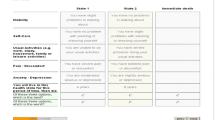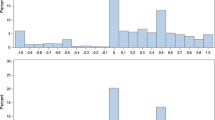Abstract
It may be difficult to value palliative health states using health state valuation methods such as the time trade-off (TTO) and standard gamble (SG) where health states are traditionally valued relative to perfect/good health and death. Chained methods have been developed to help in this context. However, few studies have compared the values produced by chained TTO and SG methods. To address this issue, a study was conducted to measure the health state values associated with oesophageal cancer using chained TTO and SG techniques. The methods were found to be acceptable amongst the sample respondents, who had previously been treated for oesophageal cancer. There were no significant differences between the health state values produced by the TTO and the SG methods. Within each method, however, there were significant differences between the health states valued. It is concluded that the use of health state valuation techniques such as the TTO and SG is feasible amongst people with a history of oesophageal cancer.
Similar content being viewed by others
References
Botterweck AAM, Schouten LJ, Volovics A, Dorant E, van den Brandt PA (2000) Trends in incidence of adenocarcinoma of the oesophagus and gastric cardia in ten European countries. Int J Epidemiol 29:645–54
Torrance GW (1986) Measurement of health state utilities for economic appraisal: a review. J Health Econ 5:1–30
Llewellyn-Thomas H, Sutherland HJ, Tibshirani R, Ciampi A, Till JE, Boyd NF (1982) The measurement of patients’ values. Med Decis Making 2:449–62
Rutten-van Mölken MP, Bakker CH, van Doorslaer EK, van der Linden S (1995) Methodological issues of patient utility measurement: experience from two clinical trials. Med Care 33:922–937
Hayman JA, Fairclough DL, Harris JR, Weeks JC (1997) Patient preferences concerning the trade-off between the risks and benefits of routine radiation therapy after conservative surgery for early-stage breast cancer. J Clin Oncol 15:1252–1260
Jansen SJT, Stiggelbout AM, Wakker PP, Vliet Vlieland TPM, Leer JWH, Nooy MA, Kievet J (1998) Patients utilities for cancer treatments: a study of the chained procedure for the standard gamble and time tradeoff. Med Decis Making 18:391–399
Morrison GC, Neilson A, Malek M (1998) Improving the sensitivity of the time trade off method: results of an experiment using chained TTO questions. Department of Economics Discussion Paper No. 98/22, University of Nottingham, Nottingham
de Haes JCJM, Stiggelbout AM (1996) Assessment values, utilities and preferences in cancer patients. Cancer Treat Rev 22:13–26
Stiggelbout AM, Kiebert GM, Kievit J, Leer JWH, Habbema JDF, de Haes JCJM (1995) The “utility” of the time trade-off method in cancer patients: feasibility and proportional trade-off. J Clin Epidemiol 48:1207–1214
Van der Donk J, Levendag PC, Kuijpers AJ, Roest FHJ, Habbema JDF, Meeuwis CA, Schmitz PIM (1995) Patient participation in clinical decision-making for treatment of T3 laryngeal cancer: a comparison of state and process utilities. J Clin Oncol 13:2369–2378
Gerber ER, Wellens TR (1997) Perspectives on pretesting: “cognition” in the cognitive interview. BMS Bull Methodol Sociol 55:18–39
Furlong W, Feeny D, Torrance GW, Barr R, Horsman J (1990) Guide to design and development of health-state utility instruments. Centre for Health Economics and Policy Analysis Working Paper No. 90–9, McMaster University, Hamilton, Ontario
Torrance GW (1987) Utility approach to measuring health-related quality of life. J Chron Dis 40:593–600
Gudex C (1994) Standard gamble user manual: Props and self-completion method. Centre for Health Economics, University of York, York
Gudex C (1994) Time trade-off user manual: props and self-completion method. Centre for Health Economics, University of York, York
Kind P (1996) The EuroQol instrument: an index of health-related quality of life. In: Spilker B (ed) Quality of life and pharmacoeconomics in clinical trials. Lippincott-Raven, Philadelphia
Dresner SM, Griffin SM (2000) Pattern of recurrence following radical oesophagectomy with two-field lymphadenectomy. Br J Surg 87:1426–1433
Dolan P, Gudex C, Kind P, Williams A (1996) The time trade-off method: results from a general population study. Health Econ 5:141–154
Stalmeier PFM (2002) Discrepancies between chained and classic utilities induced by anchoring with occasional adjustments. Med Decis Making 22:53–64
Chapman GB, Elstein AS, Kuzel TM, Sharifi R, Nadler RB, Andrews A, Bennett CL (1998) Prostate cancer patients’ utilities for health states: how it looks depends where you stand. Med Decis Making 18:278–286
Boyd NF, Sutherland HJ, Heasman KZ, Tritchler DL, Dummings BJ (1990) Whose utilities for decision analysis? Med Decis Making 10:58–67
Sackett DL, Torrance GW (1978) The utility of different health states as perceived by the general public. J Chron Dis 31:697–704
Llewellyn-Thomas HA, Sutherland HJ, Thiel EC (1993) Do patients’ evaluations of a future health state change when they actually enter that state? Med Care 31:1002–1012
Jansen SJT, Kievet J, Nooij MA, Stiggelbout AM (2001) Stability of patients’ preferences for chemotherapy: the impact of experience. Med Decis Making 21:295–306
Cook J, Richardson J, Street A (1994) Cost utility analysis of treatment options for gallstone disease: methodological issues and results. Health Econ 3:157–168
Dolan P (1996) Modelling valuations for health states: the effect of duration. Health Policy 38:189–203
Acknowledgements
The study was funded by the National Health Service Health Technology Assessment Programme. The authors would like to thank Pauline Potts for her assistance in processing the data and the patients for their contribution to the study.
Author information
Authors and Affiliations
Corresponding author
Additional information
Financial support for this study was provided by the National Health Service Technology Assessment (NHS HTA) Programme, project number 96/06/07. The funding agreement ensured the authors’ independence in designing the study, interpreting the data, writing and publishing the paper.
Appendix 1: Health and treatment descriptions used in interviews
Appendix 1: Health and treatment descriptions used in interviews
Good health
-
1.
You lead an active life and find work and other interests/activities rewarding.
-
2.
You have good relations with family and friends.
-
3.
You have a healthy lifestyle in terms of diet and leisure activities.
-
4.
You have a positive approach to life and rarely feel anxious or depressed.
-
5.
You have no health problems which cause pain or discomfort.
-
6.
You welcome new challenges and feel optimistic about the future in both work and personal life.
Health state 1
-
1.
You can eat all sorts of raw and cooked food.
-
2.
You eat your usual amount of food.
-
3.
You do not have any problems carrying out your usual daily activities (these may include visiting friends/family, housework, leisure activities, going out for meals).
-
4.
You may have one of the following symptoms: pain, shortness of breath.
Health state 2
-
1.
You find it difficult to eat hard, solid foods.
-
2.
You eat less.
-
3.
You have some problems carrying out your usual daily activities.
-
4.
You may have one or more of the following symptoms: pain, shortness of breath, vomiting and regurgitation.
Health state 3
-
1.
You cannot eat any solid foods.
-
2.
You eat a lot less.
-
3.
You have frequent problems carrying out your usual daily activities.
-
4.
You will have two or more of the following symptoms: pain, shortness of breath, vomiting and regurgitation, weak/sore muscles, loss of taste, bad breath.
Health state 4
-
1.
You are limited to a completely liquid diet.
-
2.
You are not able to eat or drink much before feeling full.
-
3.
You have a lot of problems carrying out your usual daily activities.
-
4.
You will have three or more of the following symptoms: pain, shortness of breath, vomiting and regurgitation, weak/sore muscles, loss of taste, bad breath.
Health state 5
-
1.
You cannot swallow at all.
-
2.
You are not able to eat or drink anything.
-
3.
You are not able to carry out your usual daily activities.
-
4.
You will have four or more of the following symptoms: pain, shortness of breath, vomiting and regurgitation, weak/sore muscles, loss of taste, bad breath, dry mouth, drooling saliva, persistent cough and wheeze.
Treatment 1
You have frequent problems carrying out your usual daily activities (these may include visiting friends/family, housework, leisure activities, going out for meals). You are about to receive treatment which involves:
-
1.
Making one trip to hospital
-
2.
Being admitted to hospital for two nights
-
3.
Having moderate pain for a few days after treatment
After treatment you are less likely to have problems carrying out your daily activities.
Treatment 2 (identical to treatment 1 apart from the following:)
-
1.
Making one trip to hospital
-
2.
Not being admitted to hospital
-
3.
Having moderate pain for 2 weeks after treatment
Treatment 3 (identical to treatment 1 apart from the following:)
-
1.
Making two or three trips to hospital
-
2.
Being admitted to hospital for one night on each trip
-
3.
Having mild pain for a few days after each treatment
Interessenkonflikt:
Keine Angaben
Rights and permissions
About this article
Cite this article
McNamee, P., Glendinning, S., Shenfine, J. et al. Chained time trade-off and standard gamble methods. HEPAC 5, 81–86 (2004). https://doi.org/10.1007/s10198-003-0217-y
Issue Date:
DOI: https://doi.org/10.1007/s10198-003-0217-y




